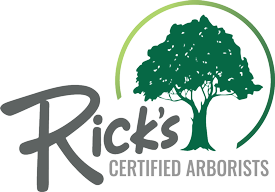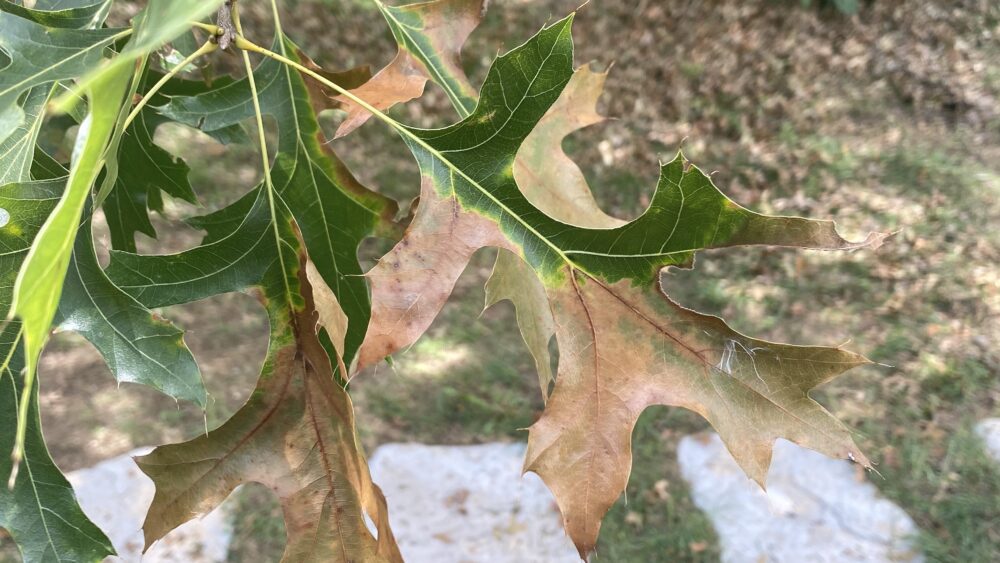If you have noticed that your trees’ leaves are turning brown and falling out of season, you may be dealing with bacterial leaf scorch. Call Rick’s PHC Certified Arborists at 610-840-2655 to make an appointment for a consultation.
What is Bacterial Leaf Scorch?
Bacterial Leaf Scorch (sometimes called Marginal Leaf Burn) is a progressive disease caused by Xylella fastidiosa, a bacterium affecting nutrient and water-conducting tissues (the xylem) in many deciduous trees. When the xylem becomes infected, the tree cannot get enough water and nutrients to the leaves. The disease slowly progresses season by season. Tree species most commonly affected are Oak, Elm, Sycamore, and Maple.
Symptoms
The primary symptom of Bacterial Leaf Scorch is browning leaves too early in the year. The first leaves affected are the oldest of the season, progressing to the newest leaves at the tips of the branches. When you closely examine the leaves, you will notice that the browning starts at the edges and progresses toward the middle. Leaves tend to start turning brown in mid-summer.
Bacterial Leaf Scorch is commonly mistaken for Dutch Elm Disease or Oak Wilt. However, these other diseases can kill a tree quickly, while Bacterial Leaf Scorch is slower to cause limb death.
The foliar disease can also be mistaken for environmental stress. However, environmental problems cause quicker reactions from the tree. Over the years, repeated Bacterial Leaf Scorch cycles weaken the tree and can cause death.
To reliably diagnose your tree, you will need to consult with a Certified Arborist or send your leaf material out to a government or university extension service for testing.
Treatment
If your tree has Bacterial Leaf Scorch, prune dead wood and branches with symptomatic leaves. Unfortunately, there are few treatments available for bacterial leaf scorch. Certified Arborists can apply antibiotic trunk injections with tetracycline to relieve some symptoms.
Prevention
Make sure to keep your wooded areas clean. After use, remove infected branches and disinfect your pruning tools with a bleach solution. Do not leave dead wood, leaves, or branches near susceptible trees.
Keep trees healthy by watering well, mulching appropriately, and fertilizing. Healthy trees are less likely to become infected.
Are You a Good Candidate for Bacterial Leaf Scorch Treatment?
If you have signs of Bacterial Leaf Scorch on your property, you may worry that you have no options to save your trees. Our Certified Arborists will examine your situation and create a plan to maximize tree survival.
Why Choose Rick’s PHC Certified Arborists?
Our Certified Arborists are experts at diagnosing and treating tree diseases. We are familiar with the local area and can formulate solutions to many of your tree problems.
No matter whether you have native trees or ornamentals on your property, we can make a plan to keep them healthy and attractive for years to come.
Frequently Asked Questions About Bacterial Leaf Scorch
Here are customer questions about this disease:
How does Bacterial Leaf Scorch spread?
Insects called spittlebugs and leafhoppers spread the bacteria between trees. Root grafting can also spread the disease.
How can I tell the difference between drought damage and Bacterial Leaf Scorch?
Trees that are losing their leaves due to a severe lack of water and trees infected with Bacterial Leaf Scorch look similar on the surface. However, check closely for when and where the browned leaves appear. With Bacterial Leaf Scorch, the leaves will brown first on lower branches and older leaves closer to the trunk. Drought-affected leaves appear first on upper branches and younger leaves. A lab diagnosis is generally needed to confirm the presence of Bacterial Leaf Scorch.
Is there a cure for Bacterial Leaf Scorch?
Bacterial Leaf Scorch is not currently curable but treatable by qualified Arborists. Antibacterial trunk injections can relieve some of the symptoms.
How long does it take Bacterial Leaf Scorch to kill trees?
Typically, it can take about 8 to 10 years for an untreated tree to succumb to the disease. Pruning dead branches and affected limbs could extend the tree’s life.
What tree varieties are resistant to Bacterial Leaf Scorch?
Many tree varieties can resist Bacterial Leaf Scorch. These include Black Gum, Beech, and Buckeye. Consider planting these varieties to replace damaged trees in your landscape.
Call Rick’s PHC Certified Arborists
If you’ve noticed possible signs of Bacterial Leaf Scorch, our Certified Arborists may be able to help. Call Rick’s PHC Certified Arborists at 610-840-2655 for expert diagnosis and treatment of your trees.


Comments are closed.